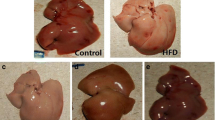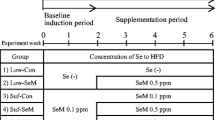Abstract
Twenty-nine obese female Zucker rats (fa / fa) were fed with a laboratory chow supplemented or not with a selenium-rich yeast (Selenion), or Selenion + vitamin E, or vitamin E alone. Twelve lean female Zucker rats (Fa / Fa) of the same littermates fed with the same diet were used as control. After 32 wk of diet, obesity induced a large increase in plasma insulin and lipid levels. A significant decrease in the plasma vitamin E/triglycerides ratio (p < 0.005) and an increase in plasma thiobarbituric reactive substances (TBARS) (p < 0.005) were also observed. Plasma selenium and vitamin E increased in all supplemented rats. The plasma insulin level was decreased by selenion supplementation and the vitamin E/triglycerides ratio was completely corrected by double supplementation with Selenion + vitamin E. TBARS were also efficiently decreased in two obese groups receiving vitamin E.
In plasma, adipose tissue and aorta, obesity induced an increase in palmitic acid (C16:0), a very large increase in monounsaturated fatty acids (palmitoleic acid C16:l, stearic acid C18:l) associated with a decrease in polyunsaturated n-6 fatty acids (linoleic acid C18:2 n - 6, arachidonic C20:4 n - 6). These alterations in fatty acid distribution were only partly modulated by Se and vitamin E supplements. However, in the aorta, antioxidant treatment in obese rats significantly reduced the increase in C16:0 and C16:l (p < 0.05 andp < 0.01, respectively) and the decrease in arachidonic acid (p < 0.05). These changes could be beneficial in the reduction of insulin resistance and help to protect the vascular endothelium.
Similar content being viewed by others
References
L. M. Zucker and H. N. Antoniades, Insulin and obesity in the Zucker genetically obese rat “fatty,”Endocrinology 90, 1320–1330 (1972).
A. Bach, H. Schirardin, M. Bauer, A. Schaeffer, and A. Weryha, Age-related changes in biological parameters in Zucker rats,Lipids 16, 841–848 (1981).
J. P. Blond, G. Henchiri, and J. Bezard, A6, A5 desaturase activities in liver from obese Zucker rats at different ages,Lipids 20, 389–395 (1989).
Y. Huang, D. Horrobin, M. Manku, J. Mitchell, and M. Ryan, Tissue phospholipid fatty acid composition in the diabetic rat,Lipids 19, 367–370 (1984).
R. Takahashi and D. Horrobin, Linoleic acid induced fatty acid changes in platelet and aorta of the rat: effect of age and cholesterol,Lipids 23, 885–890 (1988).
S. Ridra, D. Heudes, O. Michel, L. Penicaud, and A. Ktorza, Increased SMC proliferation after endothelial injury in hyperinsulinemic obese Zucker rats,Am. J. Physiol. 267, H1976-H1983 (1994).
C. F. Saladino, M. Scheneider, E. A. Jonas, and G. Grimes, Parenteral lipid emulsioninduced atherosclerosis in the obese Zucker rats and its lean littermate,Artery 19, 297–306 (1992).
R. M. Amy, P. J. Dolphin, R. A. Pederson, and J. C. Russell, Atherogenesis in two strains of obese rats. The fatty Zucker and LA/N-corpulent rats,Atherosclerosis 69, 199–209 (1988).
D. Steinberg, S. Parthasarathy, T. E. Crew, J. C. Khoo, and J. L. Witzum, Beyond cholesterol modification of low density lipoproteins that increase its atherogenicity,New Engl. J. Med. 320, 915–924 (1989).
E. Dworschak, G. Biro, G. Pados, M. Horvath, A. Lugasi, and A. Zsinka, Lipid characteristics and malondialdehyde level in the sera of obese people,Z. Ernahrungswiss 26, 165–170 (1987).
J. C. Ruf, M. Ciavatti, T. Gustafsson, and S. Renaud, Effect of PP-56 and vitamin E treatment on platelet hyperaggregability, fatty acid abnormalities, and clinical manifestations in streptozotocin-induced diabetic rats,Diabetes 40, 233–239 (1991).
J. C. Ruf, M. Ciavatti, T. Gustafsson, and S. Renaud, Effect of D-myoinositol on platelet function and composition and cataract development in streptozotocininduced diabetic rats,Biochem. Med. Metab. Biol. 48, 46–55 (1992).
C. Douillet, A. Tabib, M. Bost, M. Accominotti, F. Borson-Chazot, and M. Ciavatti, A selenium supplement associated or not with vitamin E delays early renal lesions in experimental diabetes in rats,Proc. Soc. Exp. Med. 211, 323–331 (1996).
C. Douillet, M. Bost, M. Accominotti, F. Borson-Chazot, and M. Ciavatti, In vitro and in vivo effect of selenium and selenium with vitamin E on platelet functions in diabetic rats, relationship to platelet sorbitol and fatty acid distribution,Biol. Trace Element Res. 55, 263–277 (1996).
F. Ursini and A. Bindoli, The role of selenium peroxidases in the protection against oxidative damage of membranes.Chem. Phys. Lipids 44, 225–279 (1987).
J. C. Sloan and T. R. J. Lappin, Automated colorimetric determination of a tocopherol,Clin. Chim. Acta 119, 197–207 (1982).
J. C. Dousset, M. Trouilh, and M. J. Foglietti, Plasma malondialdehyde levels during myocardial infarction,Clin. Chim. Acta 129, 319–322 (1983).
A. T. Quintanilha and L. Packer, Membrane effects of vitamin E deficiency and surface change density studies of skeletal muscle and liver mitochondria,Ann. NY Acad. Sci. 393, 31–45 (1982).
B. Welz, M. Melcher, and G. Schlemmer, Accuracy of the selenium determination in human body fluids using atomic absorption spectrometry,Trace Element Anal. Chem. Med. Biol. 3, 207–215 (1984).
J. M. Folch, M. Lees, and S. G. H. Sloane, A simple method for the isolation and purification of total lipids from animal tissues,J. Biol. Chem. 226, 497–507 (1957).
C. Douillet and M. Ciavatti, Effect of vitamin E treatment on tissue fatty acids and cholesterol content in experimental diabetes,J. Nutr. Biochem. 6, 319–326 (1995).
W. J. Morrison and L. M. Smith, Preparation of fatty methyl esters and dimethyl acetals from lipids with boron fluoride methanol,J. Lipid Res. 5, 600–608 (1964).
B. S. Rose, W. P. Flatt, R. J. Martin, and R. D. Lewis, Whole body composition of rats determined by dual X-ray absorptiometry is correlated with chemical analysis,J. Nutr. 128, 246–250 (1998).
J. H. McNeil, H. L. M. Delgatty, and M. L. Battell, Insulin-like effects of sodium selenate in streptozotocin-induced diabetic rats,Diabetes 40, 1975–1678 (1991).
S. R. Stapleton, G. Garcock, K. Foelini-Adams, and R. T. Kletzien, Selenium: potent stimulator of tyrosyl phosphorylation and activator of MAPkinase,Biochim. Biophys. Acta 1355, 259–269 (1997).
A. Q. Galvain, E. Muscelli, C. Catalano, A. Natali, G. Sanna, A. Masoni, et al., Insulin decreases circulating vitamin E levels in humans,Metabolism 45, 998–1003 (1996).
B. H. Jones, M. A. Maher, W. J. Banz, M. B. Zemel, J. Whelan, P. J. Smith, et al., Adipose tissue stearoyl-CoA mRNA is increased by obesity and decreased by polyunsaturated fatty acids,Am. J. Physiol. 271, E44-E49 (1996).
L. C. St John and F. P. Bell, Arterial lipid biochemistry in the spontaneously hyperlipidemic Zucker rat and its similarity to early atherogenesis,Atherosclerosis 86, 139–144 (1991).
T. Shimamura, L. Famortosa, A. C. Wilson, L. Lelkes, and A. K. Khachadurian, Atherosclerosis and glomerulosclerosis in WHHL rabbits and obese Zucker rats,Jpn. J. Exp. Med. 60, 105–109 (1990).
K. W. J. Whale and J. D. Radcliffe, Effect of a diet rich in sunflower oil on aspects of lipid metabolism in the genetically obese rat,Lipids 12, 135–139 (1977).
P. H. Guesnet, J. M. Bourre, M. Guerrre Milo, G. Pascal, and G. Durand, Tissue phospholipid fatty acid composition in genetically lean (Fa/-) or obese (fa/fa) Zucker female rats on the same diet,Lipids 25, 517–522 (1990).
J. Blond, P. Precigou, and J. Bezard, Fatty acid composition of platelet phospholipids and plasma lipids in obese Zucker rats,Arch. Int. Physiol. Biochim. 96, 41–49 (1988).
V. Salomaa, I. Ahola, J. Tuomilehto, A. Aro, P. Pietinen, H. J. Korhonen, et al., Fatty acid composition of serum cholesterol esters in different degrees of glucose intolerance: a population-based study,Metabolism 39, 1285–1291 (1990).
J. W. Hunnicutt, R. W. Hardy, J. Williford, and J. M. McDonald, Saturated fatty acidinduced insulin resitance in rat adipocytes,Diabetes 43, 540–545 (1994).
T. L. Kaduce, A. A. Spector, and R. S. Bar, Linoleic acid metabolism and prostaglandin production by cultured bovine pulmonary artery endothelial cells,Arteriosclerosis 2, 380–395 (1982).
L. H. Storlien, D. A. Pan, A. D. Kriketos, J. O’Connor, I. D. Caterson, G. J. Cooney, et al., Skeletal muscle membrane lipids and insulin resistance,Lipids 31(Suppl), S261-S265 (1996).
T. C. Lee, R. L. Wykle, M. L. Blank, and F. Snyder, Stearoyl CoA and alkyl acyl glycero phosphoryl ethanolamine desaturase in tumor,Biochem. Biophys. Res. Commun. 55, 574–579 (1973).
H. J. Povoa, N. Marcondes, L. Fernandes, and N. M. Vicente, Plasmalogens in arterial wall,Acta Biol. Med. Ger. 36, 285–286 (1977).
F. Paltauf, Ether lipid in biomembranes,Chem. Phys. Lipids 74, 101–139 (1994).
Author information
Authors and Affiliations
Rights and permissions
About this article
Cite this article
Douillet, C., Bost, M., Accominotti, M. et al. Effect of selenium and vitamin E supplementation on lipid abnormalities in plasma, aorta, and adipose tissue of Zucker rats. Biol Trace Elem Res 65, 221–236 (1998). https://doi.org/10.1007/BF02789098
Issue Date:
DOI: https://doi.org/10.1007/BF02789098




